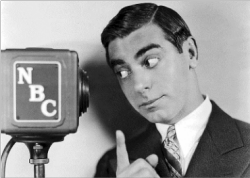 |
|
|
|
The Golden Years of Radio
1933-1934
Read This Season's Synopsis Here!
Then Click the Link to the Left to Read the Whole Article!
(There are many more fascinating
facts and stories beyond these headlines) |
|
|
|
GOld Time Radio chronicles
each of the 21 broadcast seasons, (September through June),
from Network Radio’s Golden Age, 1932 to 1953. The lengthy
and informative profiles of each season are concluded with
an exclusive review of their Top 50 Prime Time Programs, as
determined by Crossly, Hooper or Nielsen rating services.).
Each synopsis links to the full and detailed
article. |
|
|
|
 |
THE 1933-34 SEASON
Click to Read
Full Article
|
Cantor's 57.2 - Really?
The 1933-34 Season - 2nd in a Series
What Depression? The Depression was taking
its toll in 1933 and advertising was in a
slump.
Total Ad Spending in all media had plunged
57% since 1029 |
|
-
The networks‘ 1933 income decline - a hefty
19.4% - was just a bump in the road that would
lead to annual billings of over $100 Million by
the end of the decade.
Colgate-Palmolive-Peet, Kraft and Ford were
among the networks’ first time advertisers who
sponsored shows high in the season’s Top 50.
-
Standard
Brands ruled radio popularity with two of the
season’s Top Three shows and three in the first
eleven. Eddie Cantor’s top rated Chase
& Sanborn. Hour raised eyebrows with a 53.7
average Crossley rating for the season, peaking
at 57.2 in December, 1933 ... Standard’s
other established hit, Rudy Vallee’s
Thursday night Fleischmann
Yeast Hour, registered an impressive 39.8
rating for the season - good for third
place and the launching pad for Fleischmann’s
newcomer to Sunday’s Top Ten, Joe Penner’s Baker’s
Broadcast.
-
Thursday was Network Radio’s most popular night
in the 1933-34 season. But more skepticism
was
aimed at Crossley’s ratings when General Foods’ Maxwell
House Showboat jumped
a whopping 46% to second place in the 1933-34
rankings.
-
The proprietors of the Fresh
Air Taxi Company, Incorpulated, scored
the highest season’s average rating of their
careers - 29.8. Amos
& Andy’s sixth
place finish in the annual Top 50 was the
highest position
Freeman Gosden & Charles Correll
would reach for the next 14 years.
-
Radio’s growing importance as a news source was
personified by Blue’s Lowell Thomas,
whose early weeknight Crossley average had
increased 35% to 19th place in the annual Top
50. The surge placed his Sun Oil newscast in
the Top Ten every night of its broadcast during
the 1933-34 season. It was the beginning of
Thomas’ unmatched record of 13 straight years in
the nightly Top Ten, all five .nights a week.
-
NBC increased its lead among the networks with
26 of 1933-34’s Top 51 programs, (three tied for
49th place). Blue moved up to second place with
14 programs and CBS trailed with eleven.
|
|
|